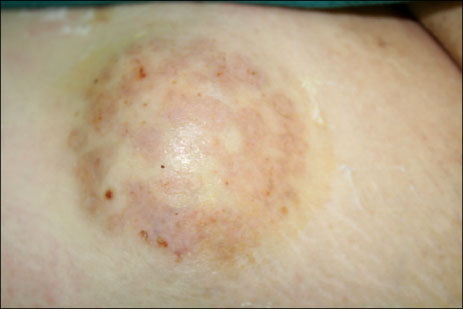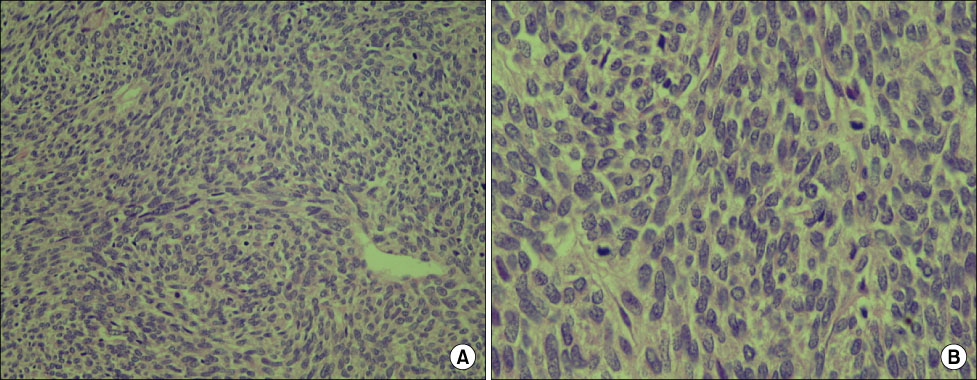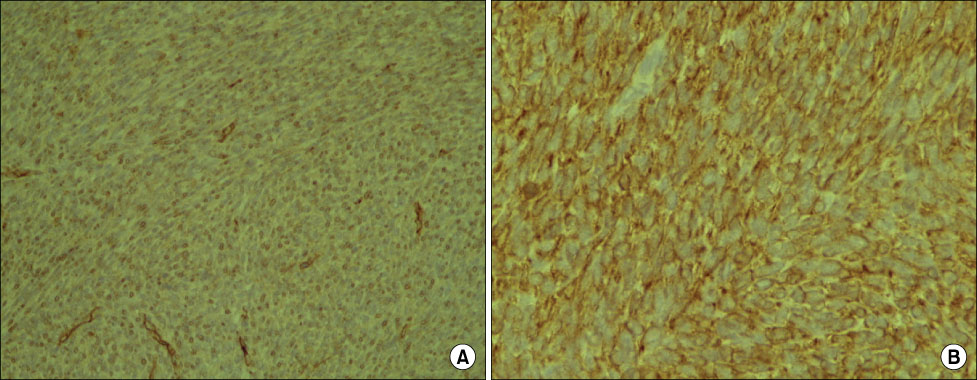J Korean Surg Soc.
2010 Dec;79(6):508-512. 10.4174/jkss.2010.79.6.508.
Solitary Fibrous Tumor That Developed in the Thigh
- Affiliations
-
- 1Department of Surgery, Seoul Paik Hospital, Inje University Medical Center, Seoul, Korea. cosmo021@hanmail.net
- 2Department of Family Medicine, Seoul Paik Hospital, Inje University Medical Center, Seoul, Korea.
- 3Department of Pathology, Seoul Paik Hospital, Inje University Medical Center, Seoul, Korea.
- KMID: 2096610
- DOI: http://doi.org/10.4174/jkss.2010.79.6.508
Abstract
- A solitary fibrous tumor (STF) is a relatively unusual neoplasm first described as a distinctive tumor arising from pleura. Some reports have shown that STF also affect extrathoracic regions. A 70-year-old woman was referred to our hospital for surgical treatment of an incidentally discovered thigh mass. We performed complete removal of the tumor. It was a soft tissue tumor with muscle indentation but without invasion to the surrounding muscles. The resected specimen was 7.0x6.3x5.2 cm. Histologically, the tumor was composed of a haphazard proliferation of spindle cells and epitheloid cells with hypercellularity and high mitotic activity. Immunohistochemistry showed positive immunoreactivity for CD34, CD99, bcl-2 protein, CD117, vimentin, smooth muscle actin and epithelial membrane antigen. We report, herein, on a rare case of malignant SFT in the thigh region along with a review of the literature.
Keyword
MeSH Terms
Figure
Cited by 1 articles
-
The Clinical Outcome of Soft Tissue Solitary Fibrous Tumor
Chang-Bae Kong, Sung Woo Choi, Sang-Hyun Cho, Won-Seok Song, Wan-Hyeong Cho, Jae-Soo Koh, Dae-Geun Jeon
J Korean Orthop Assoc. 2016;51(6):515-520. doi: 10.4055/jkoa.2016.51.6.515.
Reference
-
1. Klemperer P, Rabin CB. Primary neoplasms of the pleura: a report of five cases. Arch Pathol. 1931. 11:385–412.2. Akisue T, Matsumoto K, Kizaki T, Fujita I, Yamamoto T, Yoshiya S, et al. Solitary fibrous tumor in the extremity: case report and review of the literature. Clin Orthop Relat Res. 2003. (411):236–244.3. Moran CA, Suster S, Koss MN. The spectrum of histologic growth patterns in benign and malignant fibrous tumors of the pleura. Semin Diagn Pathol. 1992. 9:169–180.4. Gold JS, Antonescu CR, Hajdu C, Ferrone CR, Hussain M, Lewis JJ, et al. Clinicopathologic correlates of solitary fibrous tumors. Cancer. 2002. 94:1057–1068.5. Park MS, Araujo DM. New insights into the hemangiopericytoma/solitary fibrous tumor spectrum of tumors. Curr Opin Oncol. 2009. 21:327–331.6. Guillou L, Fletcher JA, Fletcher CDM, Mandahl N. Fletcher CDM, Unni KK, Mertens F, editors. Extrapleural solitary fibrous tumor and hemangiopericytoma. Pathology and Genetics of Tumours of Soft Tissue and Bone. 2002. Lyon: IARC Press;86–90.7. Si Y, Kim HJ, Kang WK, Jung CK, Oh ST. Malignant solitary fibrous tumor in the perianal region. J Korean Surg Soc. 2007. 73:443–446.8. Anders JO, Aurich M, Lang T, Wagner A. Solitary fibrous tumor in the thigh: review of the literature. J Cancer Res Clin Oncol. 2006. 132:69–75.9. Lee SC, Tzao C, Ou SM, Hsu HH, Yu CP, Cheng YL. Solitary fibrous tumors of the pleura: clinical, radiological, surgical and pathological evaluation. Eur J Surg Oncol. 2005. 31:84–87.10. Gengler C, Guillou L. Solitary fibrous tumour and haemangiopericytoma: evolution of a concept. Histopathology. 2006. 48:63–74.






